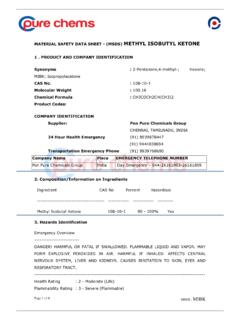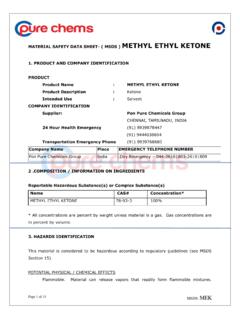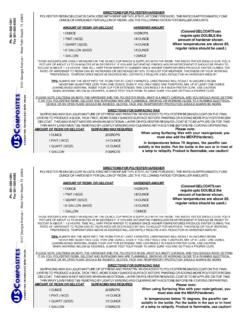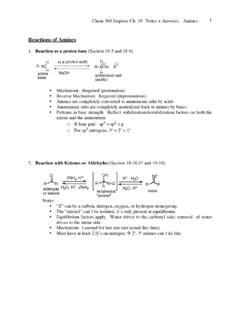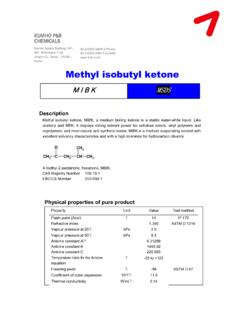Transcription of OSHA Glove Selection Chart
1 OSHA Glove Selection Chart OSHA Personal Protective Equipment Table 4 - Chemical and Liquid-Resistant Gloves Chemical-resistant gloves are made with different kinds of rubber: natural, butyl, neoprene, nitrile and fluorocarbon (viton); or various kinds of plastic: polyvinyl chloride (PVC), polyvinyl alcohol and polyethylene. These materials can be blended or laminated for better performance. As a general rule, the thicker the Glove material, the greater the chemical resistance but thick gloves may impair grip and dexterity, having a negative impact on safety. Some examples of chemical-resistant gloves include: Butyl gloves are made of a synthetic rubber and protect against a wide variety of chemicals, such as peroxide, rocket fuels, highly corrosive acids (nitric acid, sulfuric acid, hydrofluoric acid and red-fuming nitric acid), strong bases, alcohols, aldehydes, ketones, esters and nitrocompounds. Butyl gloves also resist oxidation, ozone corrosion and abrasion, and remain flexible at low temperatures.
2 Butyl rubber does not perform well with aliphatic and aromatic hydrocarbons and halogenated solvents. Natural (latex) rubber gloves are comfortable to wear, which makes them a popular general-purpose Glove . They feature outstanding tensile strength, elasticity and temperature resistance. In addition to resisting abrasions caused by grinding and polishing, these gloves protect workers hands from most water solutions of acids, alkalis, salts and ketones. Latex gloves have caused allergic reactions in some individuals and may not be appropriate for all employees. Hypoallergenic gloves, Glove liners and powderless gloves are possible alternatives for workers who are allergic to latex gloves. Neoprene gloves are made of synthetic rubber and offer good pliability, finger dexterity, high density and tear resistance. They protect against hydraulic fluids, gasoline, alcohols, organic acids and alkalis. They generally have chemical and wear resistance properties superior to those made of natural rubber.
3 Nitrile gloves are made of a copolymer and provide protection from chlorinated solvents such as trichloroethylene and perchloroethylene. Although intended for jobs requiring dexterity and sensitivity, nitrile gloves stand up to heavy use even after prolonged exposure to substances that cause other gloves to deteriorate. They offer protection when working with oils, greases, acids, caustics and alcohols but are generally not recommended for use with strong oxidizing agents, aromatic solvents, ketones and acetates. The following table from the Department of Energy (Occupational Safety and Health Technical Reference Manual) rates various gloves as being protective against specific chemicals and will help you select the most appropriate gloves to protect your employees. The ratings are abbreviated as follows: VG: Very Good; G: Good; F: Fair; P: Poor (not recommended). Chemicals marked with an asterisk (*) are for limited service.
4 *Limited service VG= Very Good G= Good F=Fair P=Poor (not recommended) Chemical Neoprene Natural Latex or Rubber Butyl Nitrile Latex *Acetaldehyde VG G VG G Acetic acid VG VG VG VG *Acetone G VG VG P Ammonium hydroxide VG VG VG VG *Amyl acetate F P F P Aniline G F F P *Benzaldehyde F F G G *Benzene F F F P Butyl acetate G F F P Butyl alcohol VG VG VG VG Carbon disulfide F F F F *Carbon tetrachloride F P P G Castor oil F P F VG *Chlorobenzene F P F P *Chloroform G P P P Chloronaphthalene F P F F Chromic Acid (50%) F P F F Citric acid (10%) VG VG VG VG Cyclohexanol G F G VG *Dibutyl phthalate G P G G Diesel fuel G P P VG Diisobutyl ketone P F G P Dimethylformamide F F G G Dioctyl phthalate G P F VG Dioxane VG G G G Epoxy resins, dry VG VG VG VG *Ethyl acetate G F G F Ethyl alcohol VG VG VG VG Ethyl ether VG G VG G *Ethylene dichloride F P F P Ethylene glycol VG VG VG VG Formaldehyde VG VG VG VG Chemical Neoprene Natural Latex or Rubber Butyl Nitrile Formic acid VG VG VG VG Freon 11 G P F G Freon 12 G P F G Freon 21 G P F G Freon 22 G P F G *Furfural G G G G Gasoline, leaded G P F VG Gasoline, unleaded G P F VG Glycerine VG VG VG VG Hexane F P P G Hydrochloric acid VG G G G Hydrofluoric acid (48%) VG G G G Hydrogen peroxide (30%)
5 G G G G Hydroquinone G G G F Isooctane F P P VG Isopropyl alcohol VG VG VG VG Kerosene VG F F VG Ketones G VG VG P Lacquer thinners G F F P Lactic acid (85%) VG VG VG VG Lauric acid (36%) VG F VG VG Lineoleic acid VG P F G Linseed oil VG P F VG Maleic acid VG VG VG VG methyl alcohol VG VG VG VG Methylamine F F G G methyl bromide G F G F * methyl chloride P P P P * methyl ethyl ketone G G VG P * methyl isobutyl ketone F F VG P methyl methacrylate G G VG F Monoethanolamine VG G VG VG Morpholine VG VG VG G Chemical Neoprene Natural Latex or Rubber Butyl Nitrile Naphthalene G F F G Naphthas, aliphatic VG F F VG Naphthas, aromatic G P P G *Nitric acid G F F F Nitromethane ( ) F P F F Nitropropane ( ) F P F F Octyl alcohol VG VG VG VG Oleic acid VG F G VG Oxalic acid VG VG VG VG Palmitic acid VG VG VG VG Perchloric acid (60%) VG F G G Perchloroethylene F P P G Petroleum distillates (naphtha) G P P VG Phenol VG F G F Phosphoric acid VG G VG VG Potassium hydroxide VG VG VG VG Propyl acetate G F G F Propyl alcohol VG VG VG VG Propyl alcohol (iso) VG VG VG VG Sodium hydroxide VG VG VG VG Styrene P P P F Stryene (100%) P P P F Sulfuric acid G G G G Tannic acid (65%) VG VG VG VG Tetrahydrofuran P F F F *Toluene F P P F Toluene diisocyanate F G G F *Trichloroethylene F F P G Triethanolamine VG G G VG Tung oil VG P F VG Turpentine G F F VG *Xylene P P P F *Limited service VG= Very Good G= Good F=Fair P=Poor (not recommended)


